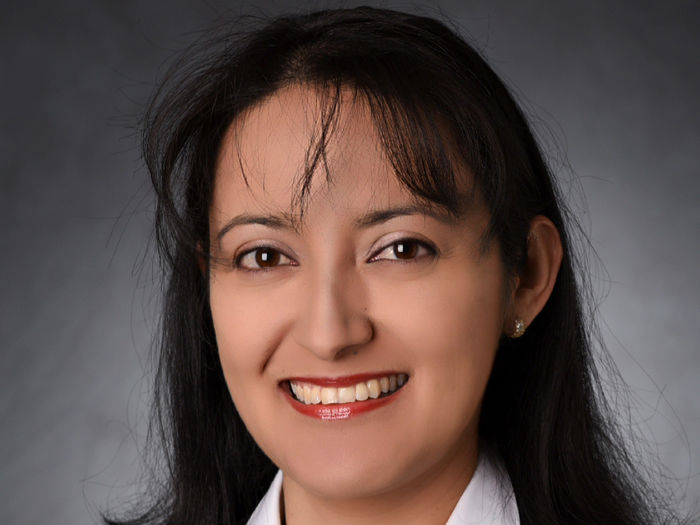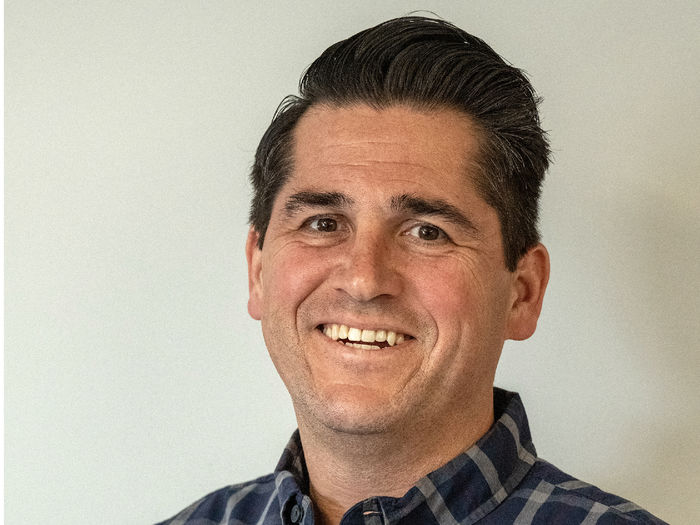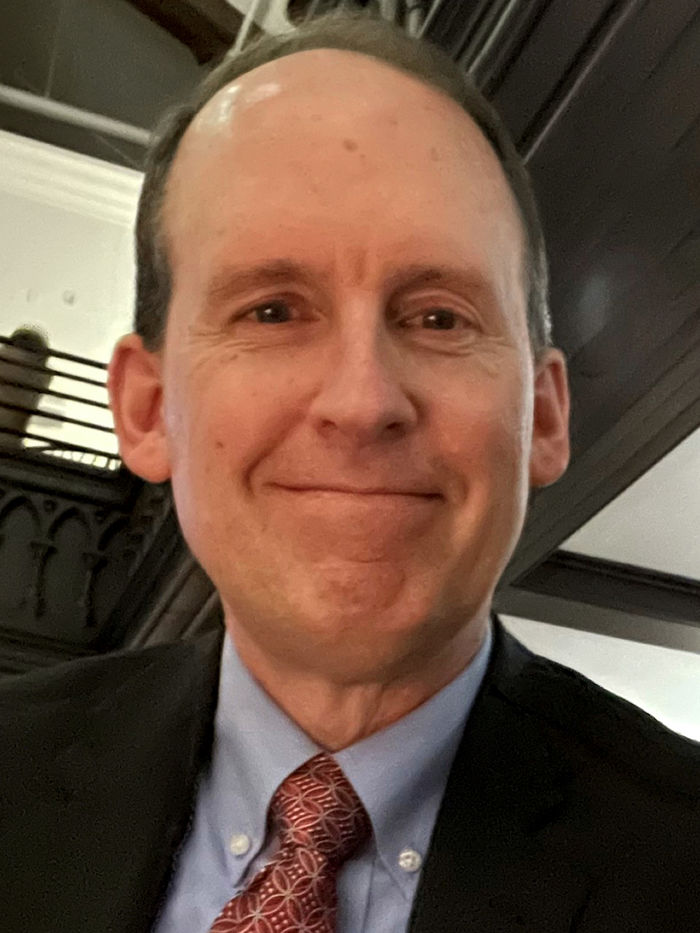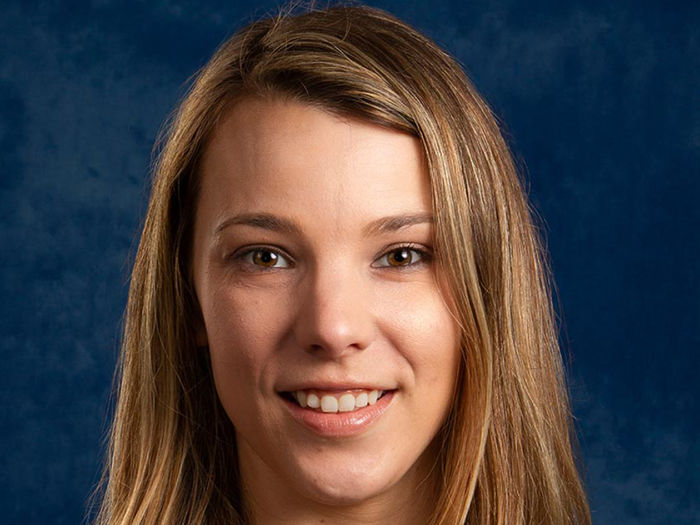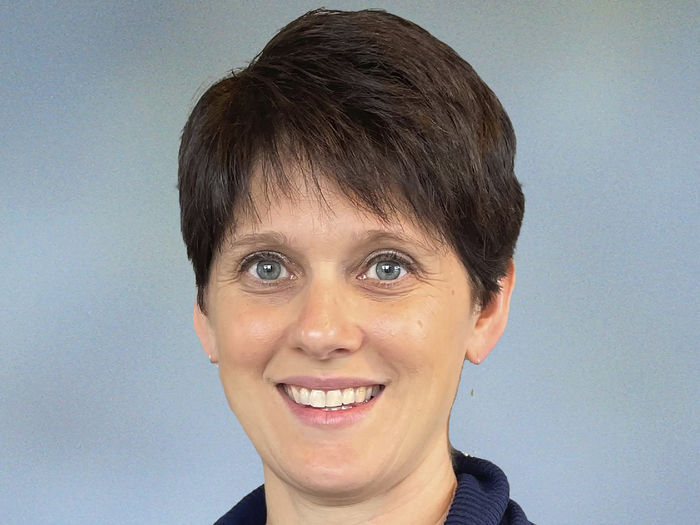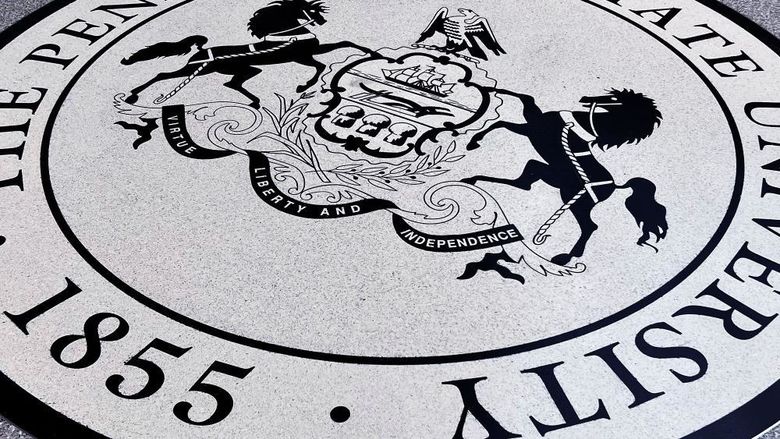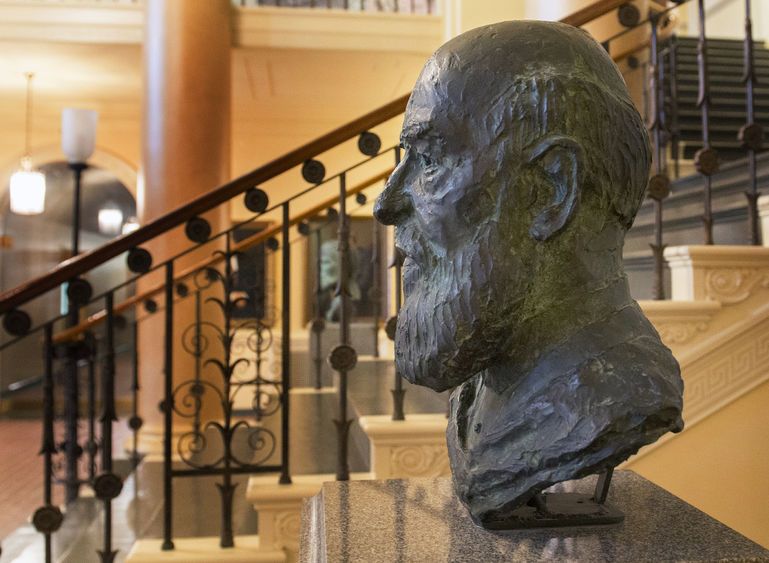
Bust of George Atherton in the Old Main lobby.
UNIVERSITY PARK, Pa. — Six Penn State faculty members have received the 2025 George W. Atherton Award for Excellence in Teaching.
They are Griselda Conejo-Lopez, assistant teaching professor of electrical engineering and computer science in the College of Engineering; Lori Gravish Hurtack, associate teaching professor of kinesiology in the College of Health and Human Development; John Craig Hammond, associate professor of history at Penn State New Kensington; Kevin Maxwell, associate teaching professor of mathematics at Penn State Fayette, The Eberly Campus; Megan Schall, associate professor of biology at Penn State Hazleton; and Maria Yoder, assistant teaching professor of nursing in the Ross and Carol Nese College of Nursing.
The award, named after Penn State’s seventh president, honors excellence in teaching at the undergraduate level.
Griselda Conejo-Lopez
Conejo-Lopez said teaching is one of her greatest joys. She loves the field of computer science and said students are always helping her find ways to better understand and break down complex concepts. It’s the two-way learning process that she finds the most rewarding.
“When I took my first two programming courses, most of my peers had prior programming experience and were already programming competitively, while others, like me, had neither owned a computer before nor had any programming background, so it was easy to ‘fall between the cracks,’” Conejo-Lopez said. “That experience made me deeply committed to ensuring that no student is left behind, no matter their background.”
That belief guides her teaching approach, which is built on three core ideas:
One size does not fit all: Because students don’t all learn the same way, teachers can’t rely on one approach. She’s always using multiple examples and walking students through the theoretical concepts.
“I provide a variety of teaching approaches so that everyone can find something that works for them,” she said.
Listen and empathize: If students feel welcome and that their opinions are valid, they’re more likely to ask for clarification when they’re confused, she said.
Embrace change: Computer programming is constantly evolving, so the lessons should, too. She stays current on the changes and adapts her lesson plans to suit this ever-changing world. Her students are changing, too, as a more diverse group of people — and larger numbers of students — join this expanding field.
“With more students curious about learning how to write computer programs, teaching large-enrollment courses can be a challenge, but I see it as an opportunity to build a strong sense of community,” Conejo-Lopez said.
She is always fine-tuning her craft. She’s taught in-person, hybrid and online courses, which she said helps her become a more dynamic instructor. She frequently attends workshops and seminars to learn new digital tools, enhance student engagement and learn new teaching strategies.
However, she learns the most from her students. She said their critical feedback allows her to know what facilitates or obstructs their learning.
“Nurturing and understanding the community from the start brings students and course staff together to advocate and support each other, and it allows me to constantly seek areas of improvement that continue to shape my teaching philosophy to become a better instructor for all of my students,” she said.
One of Conejo-Lopez’s former students said she represents the best of educators. She said Conejo-Lopez helped her the most when she was struggling and helped her find a way to succeed.
“I cannot think of any way that a teacher can be better than Griselda. She constantly inspires me with her tenacity and drive, especially as a woman in a male-dominated field,” the former student said. “While I experience imposter syndrome due to the gender imbalance, she is always there to ensure that I belong in this major and that I deserve to follow my passions. This woman has truly changed my life, and she deserves to be recognized for all that she does.”
Lori Gravish Hurtack
Gravish Hurtack said teaching is an art. She said the key to fostering learning is mentorship. She sparks conversations with students that often pique their motivation, leading to greater ambition to succeed. She’s a firm believer in one-on-one mentoring sessions and makes time to meet all of her students for these discussions on everything from course assignments to career goals.
“These sessions allow me to approach each meeting with an open mind, embrace the students' strengths, and offer supportive guidance,” she said.
She remembers a time where a former student approached her and thanked her for never giving up on him. The student was told his GPA was too low for graduate school but he persevered, becoming a board-certified neurosurgeon.
“Words are not merely words; they can either hinder or inspire,” Gravish Hurtack said. “It is not the events in our lives that define us, but how we react to and learn from them that shapes who we become.”
These continuous contacts with former students are nothing new to Gravish Hurtack. She wants her kinesiology students to be lifelong learners and remains ready to help them navigate the process.
“My philosophy of teaching is to mentor undergraduates for a lifetime. I have provided my cellphone number to every student in lectures and on the syllabus since day one,” Gravish Hurtack said. “Throughout my decades-long teaching career, I have received daily phone calls, text messages, emails, social media tags, and requests for meetups with alumni to discuss their successes, seek career advice and extend invitations to celebrate their achievements. Recently, I had the privilege of attending a live Zoom white coat ceremony for an alum pursuing a medical degree. These shared moments are what I call life’s ‘golden nuggets.’”
Her goal is that each student reaches the highest level of education, outreach and career planning. Her holistic teaching approach to this end includes discussions, listening, academic engagement and outreach. Through these channels, Gravish Hurtack said, she’s able to inspire curiosity and compassion. Her courses frequently address global learning, professional development and health disparities.
Gravish Hurtack also uses these connections with alumni to put students on the right career path. She collaborates with former students to stay current and enhance learning objectives.
“What defines me as an educator is my passion for bringing creative ideas to life that can enhance the fundamentals of student learning, outreach and humanitarianism,” Gravish Hurtack said.
A former student said Gravish Hurtack was instrumental in helping her succeed in and out of the classroom. The student secured an internship with the Nittany Lions football team and said Gravish Hurtack shadowed her along the way.
“Professor Gravish Hurtack deeply cares about the well-being of her students and their careers, academics and professional involvement,” a former student said. "She pushes her students to be the best that they can be and provide them with amazing opportunities while maintaining a personal and professional relationship with each of them. Being a student under her has made me excel because you want to submit your best work to not only get the grade but to make her proud.”
John Craig Hammond
As a faculty member at a Commonwealth Campus, Hammond offers general education courses to a diverse group of students with various backgrounds, life experiences and career objectives. He said his teaching is informed by his deep commitment to what it means to receive a Penn State education, where students leave with a well-rounded background and a deeper understanding of the humanities.
“Simply put, the best part of my job is watching first- and second-year students be transformed by learning; by seeing them accomplish more than they ever thought possible in history classes; and by imbuing in many of them an appreciation for the humanities and general education at Penn State,” Hammond said.
His courses aren’t catered to history majors. Instead, they’re designed for students enrolled in general education classes as they navigate their paths toward their degrees.
“As I see it, I have to convince smart, savvy and skeptical 18- to 20-year-olds that a history class has something valuable to teach them,” Hammond said. “I respect my students and their skepticism about the value of a history course and general education, and we use that to examine how and why a general education history class might benefit them as students, as workers, and as human beings trying to navigate their way through a confused and confusing 21st century.”
His courses give students a basic comprehension of history but also emphasize that thinking is critical to understanding, analyzing and explaining historical changes. His goal isn’t to get students to remember key dates and moments in history, but rather to understand the causes and consequences of significant historical changes and continuities.
“Regardless of the specific topic in any of my classes, students learn how to think critically, how to construct arguments using evidence and analysis, and then to consider the significance of their claims,” Hammond said. “Through all of this, we remain focused on the humanities part of history as we try to understand how people in the past understood their worlds, tried to make sense of them and then acted on it. At their best, history courses teach us empathy and humility.”
His courses are challenging and require that students develop and exercise critical reading, writing and analytical skills. Students can see the value in approach to history, which stresses the skills that students will use in both their upper-level courses and in their careers.
“It is an honor and a privilege to serve Penn State students,” Hammond said. “Through 17 years, I remain committed to providing all of my students with first-rate courses and a world-class Penn State education.”
Students said Hammond creates an environment where they are encouraged to ask questions and take an active role in the learning process. They said he’s someone who’s always available in and out of the classroom.
“He creates a welcoming and inclusive classroom environment where students are not just permitted but encouraged to ask questions and share their ideas regarding the material,” a former student said. “He is an extraordinary historian and educator who has made a significant impact on the lives of his students, especially me. His passion, expertise and dedication to teaching has put him on a pedestal above all else.”
Kevin Maxwell
Maxwell has taught math at nearly all levels, from middle school to Penn State. He said joining Fayette more than 25 years ago was a time for him to learn. He was schooled in the old school methods of teaching but soon learned of a more expansive and effective approach.
“With the help of this community of co-workers and students, I expanded my boundaries as an educator and a scholar, embraced pedagogical innovation, and abandoned the instructional model of ‘teacher as knowledge giver,’” Maxwell said. “Now, my guiding principle is understanding students’ diverse needs and doing everything possible to nurture their engagement and learning.”
To drive his students to become critical thinkers, he uses techniques based on problem-solving, discussion, service learning, peer instruction and technology. He also relies on some old tricks he learned in the middle school classroom.
“Much of what I do is based on the constructivist classroom, a model that I first used as a middle-school teacher, and this student-centered approach to teaching is apropos for college students as well,” Maxwell said. “For example, my calculus students apply differentiation to identify the best seat in a movie theater, my statistics students enact human histograms to ‘become’ the data and the graph, my trigonometry students perform the ‘wave’ to discover behaviors about the sine curve, and my finite math students search through their own closets to determine the number of outfit combinations that each student can create. Experience has taught me that students need to be active in their own learning processes, and I develop each of my courses accordingly.”
He’s always learning from his students and creates a welcoming environment where their views are valued. That allows him to get the qualitative data he needs to know what’s working best and to cast the widest net in the classroom. He’s skilled in traditional, remote and hybrid classrooms and even uses tools such as videos to enhance learning.
He also wants his students to see math isn’t just about the numbers. The data exposes real challenges and can offer effective solutions. His students work with nonprofits, solving real-world problems with skills they learned in the classroom.
“Because teaching and learning both reach beyond the classroom, my students have also performed service-learning projects to develop understanding of course topics by practicing what they are learning,” Maxwell said. “For example, statistics students completed data analyses for a local Legal Aid Society, a community center, and a health service, and calculus students tutored clients appointed through Goodwill Industries.”
Former students said Maxwell is known for his out-of-the-box approach to teaching math. Many of his students are nursing majors, so they appreciate his ability for using real-world examples and explaining how math will be useful in their careers. One lesson, the “bungie Barbie,” was a class favorite.
“We left the classroom and launched Barbie dolls with rubber bands. We used trials and the linear regression equation to calculate what would happen next,” a former student said. “I remember how excited everyone was to get out of the classroom and participate in a real-life activity using what we learned. Additionally, he used real-life stories and intertwined characteristics of health care to keep us interested.”
Megan Schall
Schall said she’s honored to be meeting students at such a critical time in their lives. They’re being challenged in this exciting time, and as they navigate a path to their future, she wants to broaden those horizons.
Her teaching philosophy centers on creating learning experiences and opportunities. She accomplishes this by first creating a rapport with her students by building their confidence, helping them see the beauty of human diversity and responding to their learning needs. For many, biology is a difficult subject. She wants to remove that barrier.
“I am often disheartened by the number of students who come into my classes with a negative perception of biology. I have learned through conversations with my students that previous experiences are powerful in shaping one’s current perception,” Schall said. “While I admit that I teach challenging science courses, I still believe that concepts can be presented in a way that overcomes learning barriers; challenging does not need to mean abstract and unrelatable. Instead, by using real-world connections, students can better relate to the importance of concepts and become more invested in understanding why science is important.”
Her courses address the relevant applications of biology. One course, on cell and molecular biology, features a lab experience where students are tasked with solving real-world scientific problems. There, students address a threat from a single-celled pathogen infecting fish in a local waterway.
“They learn to be diagnosticians and then apply those skills to their own inquiry-based experiment. In this respect, they not only understand important principles, but can connect those principles with how they are used in scientific disciplines,” Schall said. “I am inspired every year when students reach the end of their research project and connect the dots between the class material and their very own investigation.”
Another course, human genetics, gives her opportunities to discuss with her students how genetic traits make up a diverse human world. Her students explore what makes us different.
“I challenge my students to embrace differences and recognize not only the importance of genetic variability in humans, but to celebrate it,” Schall said. “Students are then tasked to research and present a genetic condition to the class. I often find that students have the courage to talk about their own genetic traits or those of family members, which is both inspiring and empowering. In all my classes, I work to create a classroom environment that promotes discussion, learning and confidence to talk openly, even about debated scientific topics. I ask students to consider multiple perspectives in science even if they do not agree with those perspectives.”
Students praised Schall’s ability to show the human side of biology and bring core concepts to life through real-world examples. They also praised her research, adding that it helps her stay current and relevant in a rapidly expanding field.
“What I admire about Dr. Schall is her hands-on experience with her subject. Because of her experience, she has a more developed understanding of her topics and can explain things from a less textbook-based perspective,” a former student said. “I appreciate her dedication to research. She understands multiple broad subjects on a delicate level, which I believe to be an excellent trait to have provided herself with this knowledge.”
Maria Yoder
Yoder said her goal as a nurse educator is to see students progress into detail-oriented professionals who provide high-quality, patient centered care. Her teaching process is guided by the nurse code of ethics: “the nurse practices with compassion and respect for the inherent dignity, worth and unique attributes of every person.”
“This statement is not only true with patients but also central in my approach to teaching; I seek to role model these behaviors to students as they begin to assimilate into our professional values,” Yoder said. “While I am not always able to engage individually with every student in my classroom, I try to see the individual in every student interaction and approach them with the respect that they deserve as an individual and demonstrate genuine care for them.”
Her students go on to assist patients, making life-changing decisions on a daily basis, so she said it’s essential she maintains high expectations. It’s her job, however, to give them the tools they need to meet these expectations.
She works with students both in larger classes and more intimate clinical groups so her teaching approach varies on the setting.
“My overarching goal is always high expectations and high support,” Yoder said. “In order to do this, I’m highly intentional in my choices and methods to help students deeply understand course content and be able to apply it to patient situations.”
Early on, she shows students real-life examples gleaned from her own experiences in the field so that students begin to realize the practical implications of what they’re learning in the classroom. Later, she invites students to share lessons they learned from clinical settings and their approaches to achieving the best outcomes for their patients.
“For example, I might ask beginner students to describe their patient’s safety or mobility needs and ask more advanced students taking pharmacology to identify why certain medications would be ordered and how to safely give them,” Yoder said. “By approaching students with a foundation of respect and care, I find that students thrive when they feel supported and are also pushed to grow.”
Some of her students who will make exceptional nurses struggle with some of the more academic portions of the curriculum. Yoder said it’s her role to seek out struggling students and find them the help they need to succeed.
“I know that I don’t get it right with every student every time, but as I approach students with respect and genuine care for the individual, set high expectations with high supports, and recognize their individual learning needs, I find great joy in watching students grow into nurses who focus on safe, high-quality, patient-centered care and know they will make a difference for their future patients,” Yoder said.
Former students said Yoder is a gifted educator with relevant experience in their field. They said she was a mentor both in the classroom and in clinical settings.
“Dr. Yoder has also continuously proven to be a reliable faculty member who effectively supports her students in all aspects of their education and caters to their individual needs,” a former student said. “She does this by being a mentor, supporter and motivator. She has previously provided guidance and encouragement to me and my fellow peers when we have expressed doubts and insecurities about our career paths.”
